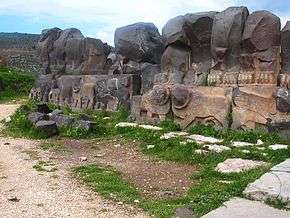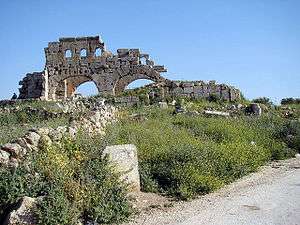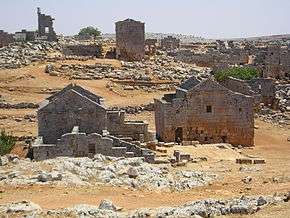Dead Cities
| Ancient Villages of Northern Syria | |
|---|---|
| Name as inscribed on the World Heritage List | |
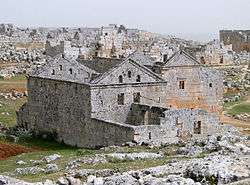 | |
| Type | Cultural |
| Criteria | iii, iv, v |
| Reference | 1348 |
| UNESCO region | Arab States |
| Inscription history | |
| Inscription | 2011 (35th Session) |
The Dead Cities (Arabic: المدن الميتة) or Forgotten Cities (Arabic: المدن المنسية) are a group of 700 abandoned settlements in northwest Syria between Aleppo and Idlib. Around 40 villages grouped in eight archaeological parks situated in north-western Syria provide an insight into rural life in Late Antiquity and during the Byzantine period. Most villages which date from the 1st to 7th centuries, became abandoned between the 8th and 10th centuries. The settlements feature the well-preserved architectural remains of dwellings, pagan temples, churches, cisterns, bathhouses etc. Important dead cities include the Church of Saint Simeon Stylites, Serjilla and al Bara.
The Dead Cities are situated in an elevated area of limestone known as Limestone Massif. These ancient settlements cover an area 20–40 km (12–25 mi) wide and some 140 km (87 mi) long.[1] The Massif includes three groups of highlands: the first is the northern group of Mount Simeon and Mount Kurd; the second middle group is the group of Harim Mountains; the third southern group is the group of Zawiya Mountain.
History

Chris Wickham, in the authoritative survey of the post-Roman world, Framing the Early Middle Ages (2006) argues that these were settlements of prosperous peasants which have few or no specifically urban features. The impressive remains of domestic architecture are the result of the prosperity of peasants who benefited from a strong international trade in olive oil at the end of Antiquity.
Another argument is that these were prosperous cities that flourished because they were located along major trade routes in the Byzantine Empire, and not merely prosperous peasant settlements. After conquest by the Arabs, the trade routes changed, and as a result these towns lost the majority of the business which fostered their economies. On this view, settlers eventually abandoned their towns and headed for other cities that were flourishing under the Arabs and the Umayyads as increasing urbanisation took its toll.
The ancient villages of the Dead Cities illustrate the transition from the ancient pagan world of the Roman Empire to Byzantine Christianity.
The majority of the dead cities are well-preserved, and tourists can access the sites quite freely despite the ongoing archaeological excavations and some restoration work, though some of the Dead Cities are quite difficult to reach without a guide.
Relatively few of the Dead Cities have any archaeological excavations taking place, and unfortunately the majority of people living in close proximity to them have no understanding of their importance. However, the local inhabitants are always welcoming to visitors.
Recently, most sites became easily accessible since many roads have been asphalted. There is a guidebook with a detailed map that is extremely useful for finding the lesser known sites; The Church of St Simeon Stylites and Other Archaeological Sites in the Mountains of Simeon and Halaqa (Arabic text by Abdallah Hadjar, translated by Paul Amish).
Dead Cites were inscribed as a UNESCO World Heritage Site in 2011, under the name of "Ancient Villages of Northern Syria".[2]
Archeological sites
Dead cities and archeological sites in Mount Simeon and Mount Kurd near Aleppo include:
- Kalota Castle and churches, located 20 km northwest of Aleppo. The castle was originally built as a Roman temple during the 2nd century AD. After converting to Christianity, the temple was turned into a basilica within the 5th century.[3] As a result of the wars between the Hamadanids and the Byzantine Empire, the church was turned into a castle during the 10th century.[4] There are two well-preserved churches near the castle: the eastern church built in 492 and the western church of the 6th century.

- Kharab Shams Basilica, one of the oldest best-preserved Christian structures in the Levant dates to the fourth century CE.[5] The Byzantine church is located 21 km (13 mi) northwest of Aleppo.
- Fafertin Church, a half-ruined Late Roman basilica dates to 372 AD; it is located 22 km (14 mi) northwest of Aleppo. According to the Aleppine historian Abdallah Hajjar, Fafertin Basilica is among the oldest dated churches in the world.[6]
- Surqanya village, located 23 km (14 mi) northwest of Aleppo, preserves the remains of an old Byzantine settlement with a half-ruined sixth-century chapel.
- Kafr Kira settlement in Burj Heidar village, located 24 km (15 mi) northwest of Aleppo, has many half-ruined Christian structures dating back to the fourth and sixth centuries.
- Sinhar historic settlement, locally known as Simkhar, is located 24 km (15 mi) northwest of Aleppo in an isolated valley. The village was inhabited between the second and seventh centuries. Its Basilica is among the oldest churches in Syria and dates back to the fourth century, while the nearby chapel is sixth century.
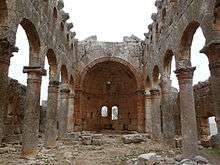
- Mushabbak Basilica, a well-preserved church from the second half of the fifth century (around 470), is located 25 km (16 mi) west of Aleppo, near the town of Daret A'zzeh.
- Barjaka or Burj Suleiman village is located 26 km (16 mi) northwest of Aleppo. The site has remnants of an old hermit tower and a well-preserved chapel from the 6th century.
- Churches of Sheikh Suleiman village, located 28 km (17 mi) west of Aleppo, is notable for its three ancient churches: a ruined church located at the centre of the village, a well-preserved southern basilica which was built in 602, and the Church of the Virgin Mary which belongs to the late fifth century and is considered one of the most beautiful churches in northern Syria.[7] There is a hermit tower in the northern side of the village.
- Kafr Nabo settlement, located 29 km (18 mi) west of Aleppo, is an Assyrian settlement of the ninth century BC and the site of a Roman temple which was converted into a church. There are also well-preserved residential buildings from the fifth and sixth centuries.
- Barad, an ancient settlement, located 32 km (20 mi) west of Aleppo, has many old basilicas; for example, the Saint Julianus Maronite monastery (399-402 AD) where the shrine of Saint Maron is located, and a basilica at the northern part of the village built in 561.
- Kimar settlement near Basuta village, located 35 km (22 mi) northwest of Aleppo, is a fifth-century CE village of the Late Roman and Byzantine eras; it has many well-preserved churches, towers and old water cisterns.
- Church of Saint Simeon Stylites (Deir Semaan), is one of the most celebrated ecclesiastical monuments in Syria and among the oldest standing Christian churches in the world. It is located about 35 km (22 mi) northwest of Aleppo.
- Sugane village, located 40 km (25 mi) northwest of Aleppo, is home to two half-ruined churches and old water cisterns.
- Ain Dara temple, an Iron Age Syro-Hittite temple dating between the tenth and eighth centuries BC, is 45 km (28 mi) northwest of Aleppo.
- Bab Al-Hawa village, located 50 km (31 mi) west of Aleppo on the Turkish border, is the site of several fourth-century churches and a well-preserved historical gate from the sixth century AD.
- Cyrrhus, an ancient city located 65 km (40 mi) north of Aleppo, is the site of Saints Cosmas and Damian Church (commonly known as Nabi Houri church), as well as a Roman amphitheatre and two old Roman bridges.
Many other sites and dead cities in the area are located at various distances around Aleppo and Idlib: Serjilla, Ebla, Bara, Qalb Loze Basilica, Baqirha Byzantine Church, Deir Mishmish Church, Benastur Monastery, Deir Amman churches, Sargible settlement, Tell A'de Church and Monastery and other settlements found in Jabal Halaqa region.
Photo gallery
See also
References
- ↑ Burns, Ross., Monuments of Syria: An Historical Guide, p.109
- ↑ UNESCO. "Ancient Villages of Northern Syria". Retrieved 2011-10-30.
- ↑ "Aleppo: Kalota village". Esyria.sy. Retrieved 2013-06-10.
- ↑ "Kalota Church". Qenshrin. Retrieved 2013-06-10.
- ↑ "Kharab Shams in history". Esyria.sy. 2008-12-13. Retrieved 2013-06-10.
- ↑ "Aleppo Fafertin Church". Esyria.sy. Retrieved 2013-06-10.
- ↑ "Walking through the ruins". Jamahir News (in Arabic).
External links
| Wikimedia Commons has media related to Dead cities. |
- Simeon Citadel and Dead Cities, Suggestion to have the Dead Cities recognized as a UNESCO world heritage site, in 2006, as part of "Simeon Citadel and Dead Cities"-project.
- Pictures of four dead cities
